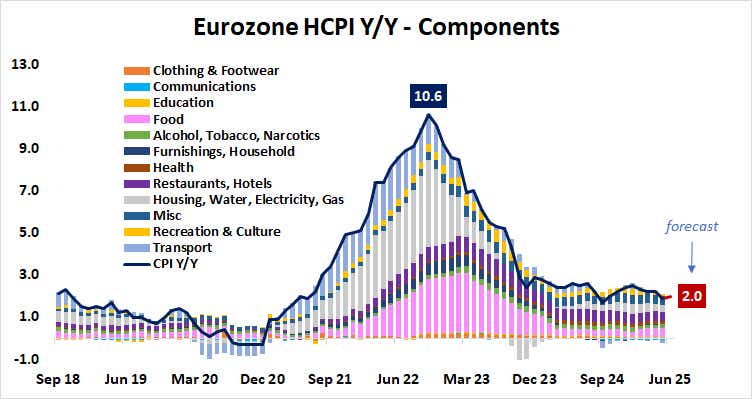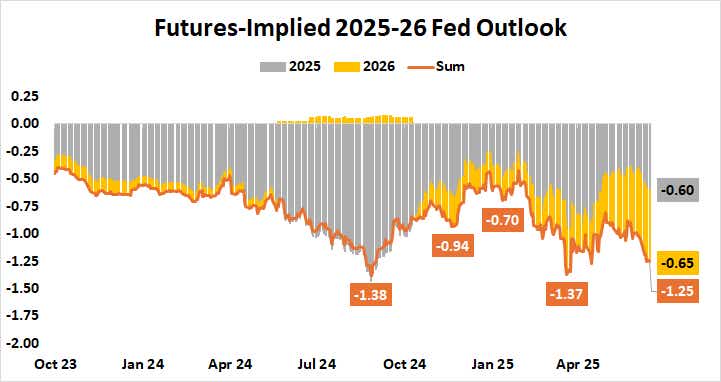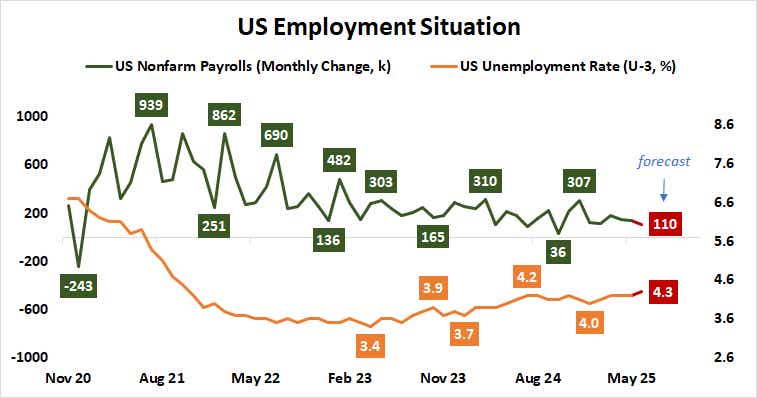Macro Week Ahead: US Jobs Data, Fed Chair Powell and Eurozone CPI

Macro Week Ahead: US Jobs Data, Fed Chair Powell and Eurozone CPI
By:Ilya Spivak
The markets and the Fed are set to clash as key US data hits the wires
- Geopolitical fears are easing after an Israel-Iran ceasefire.
- The euro is in play as Eurozone inflation data shapes ECB interest rate expectations.
- The Fed is on a collision course with markets before key US jobs data and the Powell speech.
Pricing out geopolitical risk seemed to take center stage for financial markets last week after the US forced a ceasefire on Israel and Iran after striking the Islamic Republic’s nuclear sites. Crude oil prices tellingly dropped 11.3%, pointing to ebbing supply disruption risk as worries about escalation fizzled.
Stocks roared higher, with the S&P 500 and Nasdaq 100 adding 3.4% and 4.2%, respectively. Treasury bond yields fell across the curve as the drop in crude oil waved off inflation shock concerns. Gold prices fell 2.9% and the US dollar weakened against the euro and the Japanese yen amid easing demand for defensive assets.
Against this backdrop, here are the key macro waypoints to consider in the days ahead.
Eurozone consumer price index data
Inflation in the Eurozone is expected to have moved slightly higher in June. The headline consumer price index (CPI) is seen rising 2% year-on-year, up from 1.9% in May. The core measure excluding volatile food and energy prices is seen holding steady at 2.3%, matching the two-and-a-half year low from the previous month.
The markets expect the European Central Bank (ECB) to issue one more interest rate cut this year, then pause in 2026. Benchmark ESTR futures price in 27 basis points (bps) in further rate cuts through year-end, and a meager 5bps of tightening in 2026. German CPI printed a bit cooler than expected for the same period, but the euro tellingly ignored it.

Fed Chair Powell speaks at ECB Forum
Federal Reserve Chair Jerome Powell is scheduled to speak at the annual ECB central bank forum in Sintra, Portugal. A familiar story highlighting tariff-linked uncertainty in the outlook for inflation as the reason to delay in interest rate cuts seems likely. This would echo what Powell said after June’s rate decision and in testimony to Congress last week.
The disparity between this and what the markets are seeing seems likely to become an increasingly impactful driver for price action. As of this month, the Fed expects 75bps in rate cuts by the end of 2026, with 50bps this year and 25bps thereafter. The markets have priced in nearly 125bps, spread evenly between 2025 and next year.
For their part, traders seem sanguine about inflation and angling for the Fed to shift focus to boosting the economy. Price growth expectations priced in by the bond market — so-called “break-even rates” — resumed falling in mid-May after a brief bounce. They now sit within a hair of the six-month low tagged in late April.

US employment and ISM data
A batch of high-profile US economic data will also feed into explaining why the markets are so dovish relative to the Fed. Analytics from Citigroup show outcomes have tended to disappoint relative to baseline forecasts over the past month, warning that analysts’ models are tuned too rosy. That might set the stage for downside surprises.
The Institute of Supply Management (ISM) is expected to show economic activity growth near standstill for a second consecutive month in June. Manufacturing sector activity is seen shrinking for a fourth consecutive month while the service sector wiggles to life after the first contraction in eleven months in May.
Meanwhile, the Bureau of Labor Statistics (BLS) is expected to report that job creation continued to slow. A rise of 110,000 in nonfarm payrolls is penciled in for June, which would amount to the smallest increase in eight months. The unemployment rate is seen rising to 4.3%, the highest since October 2021.

Ilya Spivak, tastylive head of global macro, has 15 years of experience in trading strategy, and he specializes in identifying thematic moves in currencies, commodities, interest rates and equities. He hosts #Macro Money and co-hosts Overtime, Monday-Thursday. @Ilyaspivak
For live daily programming, market news and commentary, visit #tastylive or the YouTube channels tastylive (for options traders), and tastyliveTrending for stocks, futures, forex & macro.
Trade with a better broker, open a tastytrade account today. tastylive, Inc. and tastytrade, Inc. are separate but affiliated companies.
Options involve risk and are not suitable for all investors. Please read Characteristics and Risks of Standardized Options before deciding to invest in options.
tastylive content is created, produced, and provided solely by tastylive, Inc. (“tastylive”) and is for informational and educational purposes only. It is not, nor is it intended to be, trading or investment advice or a recommendation that any security, futures contract, digital asset, other product, transaction, or investment strategy is suitable for any person. Trading securities, futures products, and digital assets involve risk and may result in a loss greater than the original amount invested. tastylive, through its content, financial programming or otherwise, does not provide investment or financial advice or make investment recommendations. Investment information provided may not be appropriate for all investors and is provided without respect to individual investor financial sophistication, financial situation, investing time horizon or risk tolerance. tastylive is not in the business of transacting securities trades, nor does it direct client commodity accounts or give commodity trading advice tailored to any particular client’s situation or investment objectives. Supporting documentation for any claims (including claims made on behalf of options programs), comparisons, statistics, or other technical data, if applicable, will be supplied upon request. tastylive is not a licensed financial adviser, registered investment adviser, or a registered broker-dealer. Options, futures, and futures options are not suitable for all investors. Prior to trading securities, options, futures, or futures options, please read the applicable risk disclosures, including, but not limited to, the Characteristics and Risks of Standardized Options Disclosure and the Futures and Exchange-Traded Options Risk Disclosure found on tastytrade.com/disclosures.
tastytrade, Inc. ("tastytrade”) is a registered broker-dealer and member of FINRA, NFA, and SIPC. tastytrade was previously known as tastyworks, Inc. (“tastyworks”). tastytrade offers self-directed brokerage accounts to its customers. tastytrade does not give financial or trading advice, nor does it make investment recommendations. You alone are responsible for making your investment and trading decisions and for evaluating the merits and risks associated with the use of tastytrade’s systems, services or products. tastytrade is a wholly-owned subsidiary of tastylive, Inc.
tastytrade has entered into a Marketing Agreement with tastylive (“Marketing Agent”) whereby tastytrade pays compensation to Marketing Agent to recommend tastytrade’s brokerage services. The existence of this Marketing Agreement should not be deemed as an endorsement or recommendation of Marketing Agent by tastytrade. tastytrade and Marketing Agent are separate entities with their own products and services. tastylive is the parent company of tastytrade.
tastyfx, LLC (“tastyfx”) is a Commodity Futures Trading Commission (“CFTC”) registered Retail Foreign Exchange Dealer (RFED) and Introducing Broker (IB) and Forex Dealer Member (FDM) of the National Futures Association (“NFA”) (NFA ID 0509630). Leveraged trading in foreign currency or off-exchange products on margin carries significant risk and may not be suitable for all investors. We advise you to carefully consider whether trading is appropriate for you based on your personal circumstances as you may lose more than you invest.
tastycrypto is provided solely by tasty Software Solutions, LLC. tasty Software Solutions, LLC is a separate but affiliate company of tastylive, Inc. Neither tastylive nor any of its affiliates are responsible for the products or services provided by tasty Software Solutions, LLC. Cryptocurrency trading is not suitable for all investors due to the number of risks involved. The value of any cryptocurrency, including digital assets pegged to fiat currency, commodities, or any other asset, may go to zero.
© copyright 2013 - 2025 tastylive, Inc. All Rights Reserved. Applicable portions of the Terms of Use on tastylive.com apply. Reproduction, adaptation, distribution, public display, exhibition for profit, or storage in any electronic storage media in whole or in part is prohibited under penalty of law, provided that you may download tastylive’s podcasts as necessary to view for personal use. tastylive was previously known as tastytrade, Inc. tastylive is a trademark/servicemark owned by tastylive, Inc.